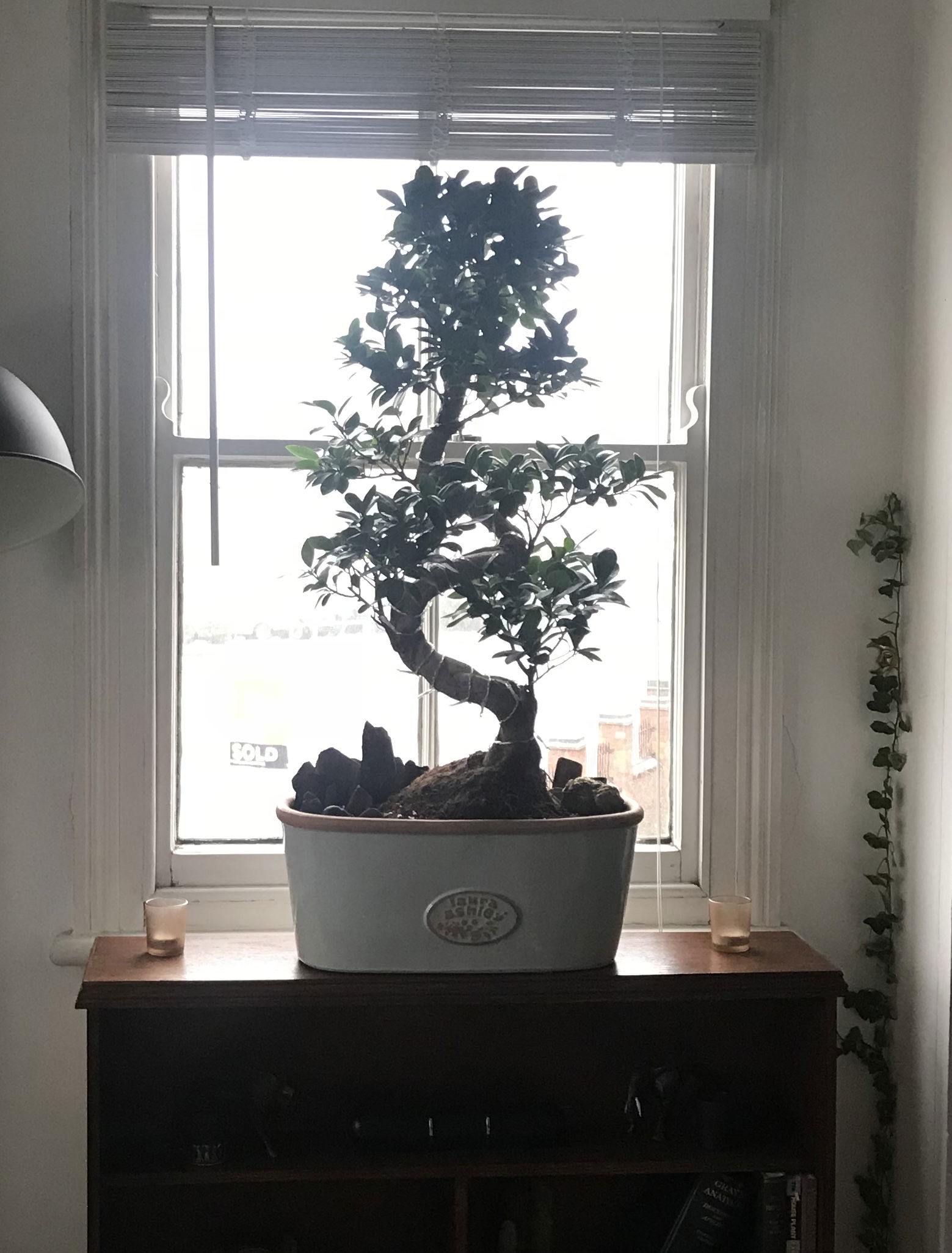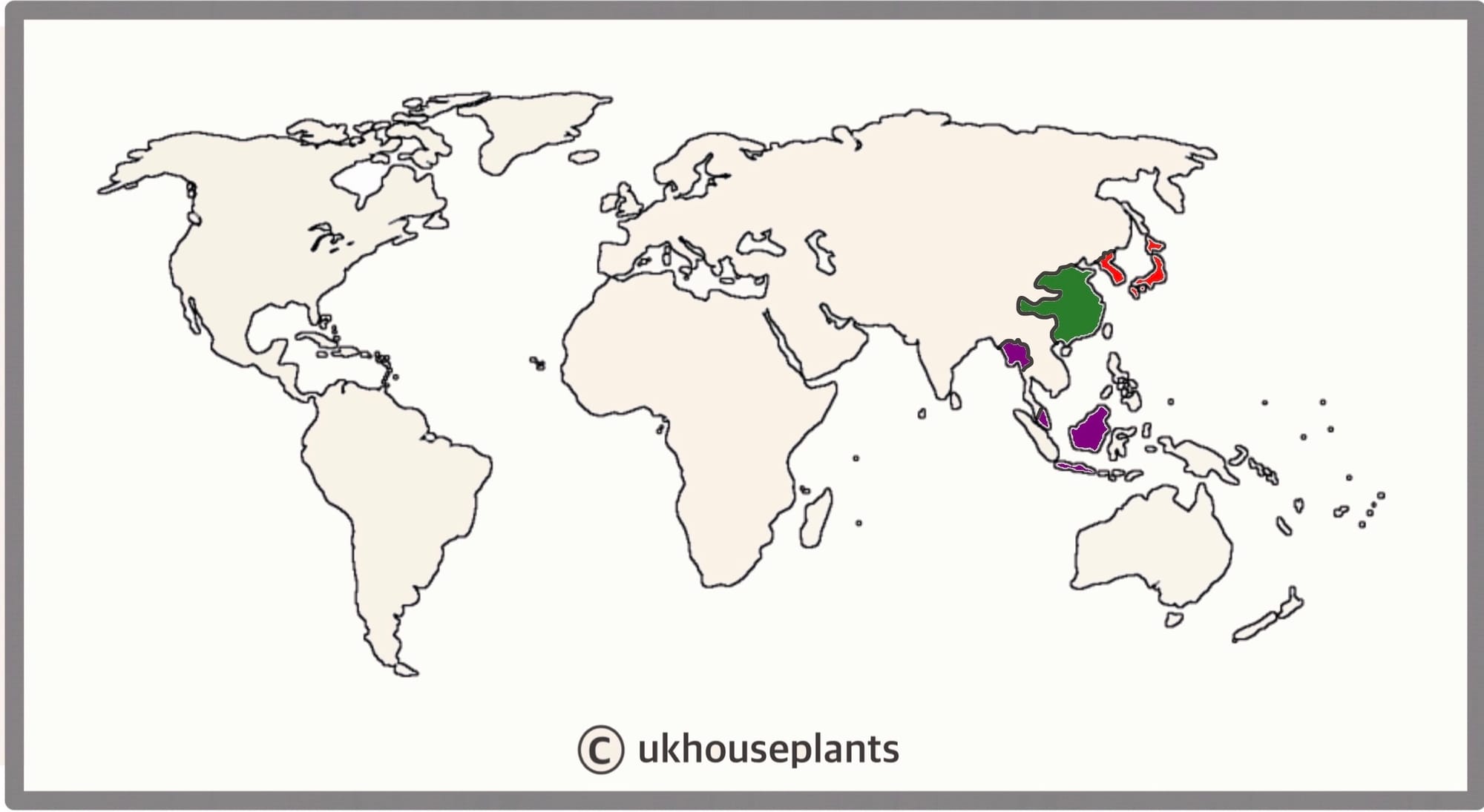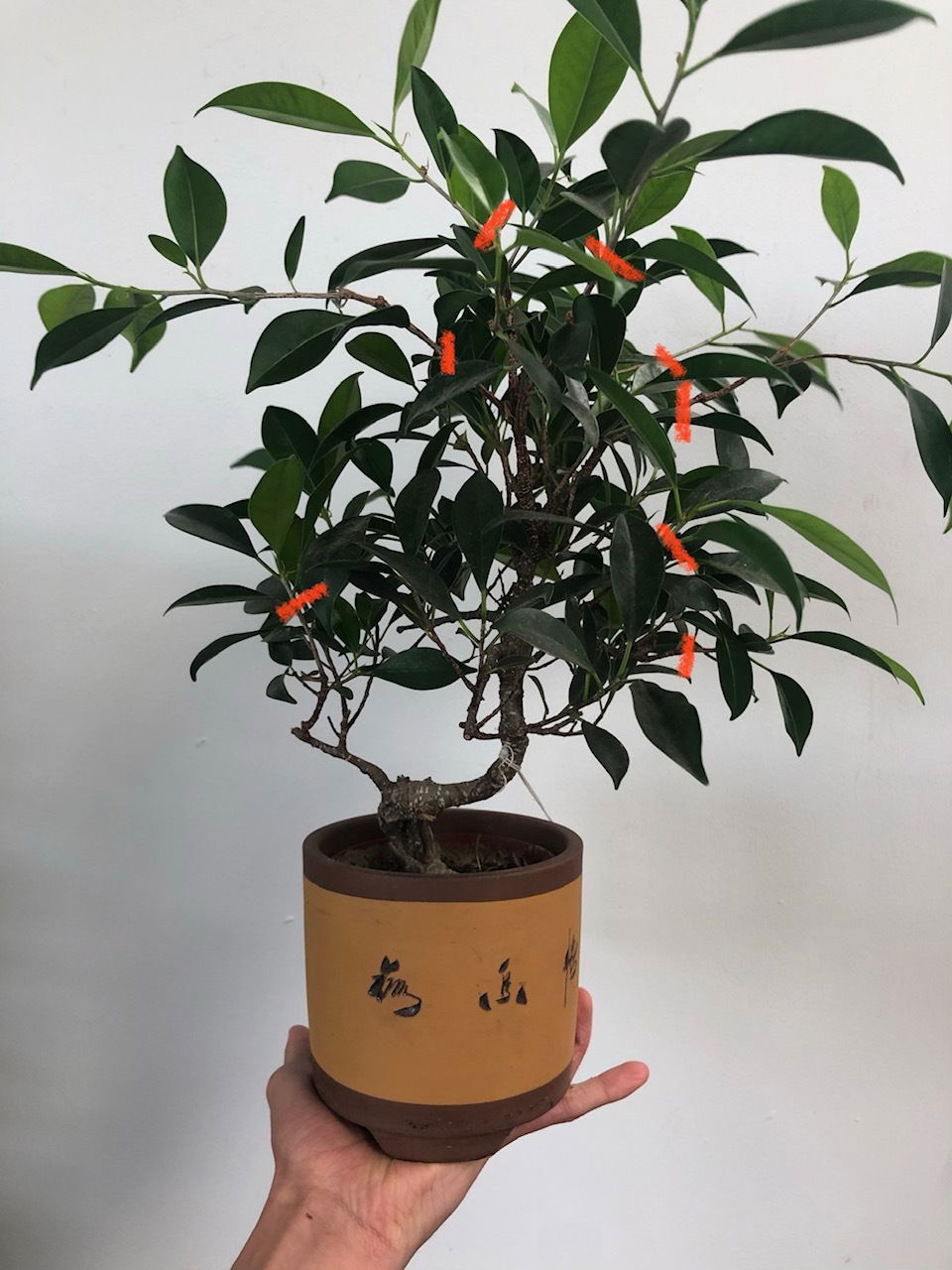
Ficus retusa
Contents
- Top Tips
- Location, Water, Humidity & Fertilisation
- Common Issues
- Origins, Temperature, Propagation, Repotting & Toxicity
Need the answer to a specific plant query? Book a 1-to-1 video call with THE HOUSEPLANT DOCTOR™, the website's friendly author, to overcome and address your niggling problem! Available on iMessage, WhatsApp, Facebook Messenger & more.
Top Tips & Info
- Care Difficulty - Easy to Moderate
- Ficus microcarpa & F. retusa have identical care requirements, which is why this article is tailored for both species. If you have a specific question about your own specimen, be sure to ask us in the comment section below!
- These two species are REMARKABLY easy specimens to care for as long as their environment is constant and reliable. Lower leaf-loss is a prominent issue with unfavored growing conditions, with its light requirements being of most importance.
- Bright, indirect light is key to quality growth; avoid excessively dark locations as it'll significantly increase the risk of soil-mould & root rot. Prolonged exposure to the sun will result in dehydration and crisping foliage.
- It's essential not to move the specimen from place to place, as a sudden change to its environment will result in shedding leaves. Once you situate the plant in a new location with no signs of older leaf-loss after three weeks, keep it there for as long as possible. This is, by far, the most critical element to successful Bonsai cultivation.
- Allow the top third of the soil to dry out in between waters, reducing this slightly in the autumn and winter months.
- Fertilise using a 'Houseplant' or 'Bonsai' labelled feed every four waters in the spring and summer, reducing this to every six in the colder months.
- Repot every three years with a 'Houseplant' or 'Bonsai' labelled potting mix and be sure to respect the roots as transplant shock is an issue that could cause wilting, sudden leaf-loss or even death.
- Keep an eye out for Spider Mites & Mealybugs that'll inhabit the plant's cubbyholes and foliage.
- Gently hose the foliage down once a month to remove the thin layer of dust and improve its overall appearance.
Location & Light - 🔸🔸
Bright exposure to a small splash of morning or evening sunlight is very beneficial for a Ficus Bonsai. It will never truly thrive in a location that offers poor lighting; if it's too dark to read a newspaper, it'll also be too shady for the Bonsai. For those who are rather forgetful with their watering habits, we'd recommend situating your specimen in a location that offers bright, indirect light with temperatures around 18℃ (64℉) for optimum growth. Avoid more than two hours of direct sun per day, especially in the height of summer.
Water - 🔸🔸
During spring and summer, maintain good soil moisture by only allowing the top third dry out in between irrigations; reduce this further during the colder months to replicate its dormancy period. One word to mention is that those situated in darker locations must be watered far less than those located in brighter ones to reduce the chance of root rot. Furthermore, never pour cold water directly into the soil as the root systems are susceptible to temperature change, which can subsequently result in lower leaf-loss. If you decide to use tap water, allow it to stand for at least 24hrs to allow the fluoride to evaporate; large quantities could build up in the soil, damaging both the roots and the overall health of the plant. Under-watering symptoms include stunted growth, dry spots appearing on the leaves and yellowing older leaves - these issues are either due to an over-crowded pot, too much light or forgetfulness. Over-watering symptoms include yellowing lower leaves, brown mushy patches developing in the stems and mouldy soil. For cases of root rot, be sure to click on this link.
Humidity - 🔸🔸
Create a humidity tray to provide a moist and stable environment for your plant. If the surrounding saturation is too low or the heat too high, its leaf-edges may start to brown over and curl, especially in direct sunlight. Hose the foliage down from time to time to hydrate the leaves and keep the dust levels down.
Specimens exposed to humidity levels around 90 - 100% are more likely to develop aerial roots that'll eventually reach the soil line for additional moist-retention and stability. This isn't just highly beneficial for the Bonsai, but it'll also improve the overall aesthetic of the woodiness itself!
Fertilisation - 🔸🔸
Feed every four waters during the growing period and every six in the autumn and winter, using a 'Houseplant' or 'Bonsai' labelled fertiliser. Never apply a 'Ready to Use’ product into the soil without a pre-water first, as it may burn the roots and lead to yellowed leaves.
Common Issues with Ficus Bonsai
Lower leaf-loss is a common and significant issue among gardeners. This unfortunate phenomenon could be a product of several different problems, most notably being dark locations, water-related abuse or environmental shock. Introduce the plant to a more well-lit area with a splash of off-peak sunlight; if caught in time, the leaf-loss should stop within a week. If you feel that you're watering habits aren't up to scratch, familiarise yourself with our care tips provided at the top of this article. It's always best to under-water Ficus Bonsai than over-do it, purely on its poor ability to endure continued sogginess. The final culprit could be down to a sudden relocation; if you've recently purchased the specimen, the chances are it is still acclimatising to the new environment. Although this shouldn't happen, a vastly different setting will cause sudden foliage-loss and stunted growth. You'll have two options of either waiting it out or presenting a more Ficus-friendly environment, mentioned in the 'Location & Light' section. For more advice regarding this matter, don't hesitate in commenting in the section below for a response.
Root rot is another common issue with specimens sat in too moist or waterlogged soil for long periods. Symptoms include rapidly yellowing leaves, stunted growth and a rotten brown base. Take the plant out of the pot and inspect health below the soil line. If the roots sport a yellow tinge, you're good to go, but if they're brown and mushy, action must be taken immediately. More information about addressing root rot can be found on this link.
Yellowing lower leaves (closest to soil) are a clear sign of over-watering, usually caused by too little light. Although Ficus Bonsai can just about do well in a shaded environment, the frequency of irrigations must be reduced to counteract the chance of root rot. People don't realise that a plant's root system needs access to oxygen too; when soil is watered, the air will travel upwards and out of the potting mix. A lack of available oxygen for the roots will cause them to subsequently breakdown over the oncoming days. Click on this link to learn more about root rot and how to address it.
Always use lukewarm water, and if you choose to use tap water, allow it to stand for at least 24hrs before application. This species tends to be quite sensitive to temperature change, so pouring cold tap water immediately into the pot will not only add fluoride into the soil, but it could even cause yellowed leaf-edges over time.
Curled leaves and brown leaf-edges are the result of too little water and over-exposure to the sun. This species is best located in bright, indirect settings, and those that haven't acclimatised to the harsh rays will show signs of sun-scorch and environmental shock. A splash of winter sunlight is acceptable as long as the soil moisture is regularly observed, with complete avoidance once summer comes along.
Origins
If you thought that Bonsai originate from Japan, you're wrong! From ancient paintings and manuscripts, historians can date evidence of 'tree art' way back to the 7th century in China, a whole five hundred years before it arrived in Japan. Ancient Buddhists had an immense passion for both flowers and plants, mainly due to the wide varieties of specimens native to the country. The Chinese name 'Penjing' grew out of favour for several reasons, and it was the Japanese term 'Bonsai', meaning 'tray planting', that stood.
Bonsai was traditionally deciduous; however, tropical plants (i.e. houseplants) have been used due to their fast-growing antics, accelerating the ageing Bonsai steps profusely. As time has progressed, many other species are being to be cultivated for forms of art; Jade Plants, Bougainvillea, Schefflera and Citrus Trees are among most notable. The latter, although not directly used for Bonsai, adopt a similar mannerism with pruning back growth to keep its overall size down for better fruiting and overall appearance.
 The Historical Distribution of Bonsai Art, from the seventh-century in China (Green) to the twelve-century in Japan & Korea (Red). The Distribution of Ficus retusa is in Purple.
The Historical Distribution of Bonsai Art, from the seventh-century in China (Green) to the twelve-century in Japan & Korea (Red). The Distribution of Ficus retusa is in Purple.
Temperature
12° - 26°C (59° - 78°F)
H1b (Hardiness Zone 12) - Can be grown outdoors during the summer in a sheltered location with temperatures above 12℃ (54℉), but is fine to remain indoors, too. If you decide to bring this plant outdoors, don't allow it to endure any direct sunlight as it may result in sun-scorch and dehydration. Regularly keep an eye out for pests, especially when re-introducing it back indoors.
Spread
For Bonsai currently under training, allow the trunk to thicken by letting it run slightly 'wild', loosening the structural wire every so often. Be patient - it'll take in the region of 4 - 10 years for the trunk to achieve the desired girth. For those that were bought from a shop, the size shouldn't change if pruned regularly.
Pruning & Maintenance
Especially for smaller Bonsai, pruning is another necessity on the list. Either use pruning scissors or fingers to take back the leggy stalks (leading growths). At the beginning of spring, be slightly brutal, as new leaves will come back and make the tree look much bushier. The image above shows where to cut as the juvenile growth can be directed in a specific direction from its alternate growth habit.
 Here's our recommended method of pruning, labelled in Red.
Here's our recommended method of pruning, labelled in Red.
Propagation
Stem & Eye Cuttings (Moderate) - This method of propagation is troublesome without the aid of bottom-heat and a controlled environment. Choose the healthiest, most established stems that are wooded, yet still juvenile enough to bend slightly, being just thicker than a pencil. Each cutting should only have ONE leaf, and a small portion of the stem to either side of the node. Cut directly below a node using a clean knife to reduce bacteria count. Situate the cutting into moist 'Houseplant' compost, with the only the leaf sticking out of the soil. Blackleg can occur when the bottom wound becomes infected, resulting in propagation failure - typically caused by water-logging or a too-damaged wound. Maintain bright light and evenly moist soil with the avoidance of direct sunlight or cold draughts. Wrap the pot (& foliage) in a transparent bag or within a miniature greenhouse, and provide bottom hear of temperatures above 18°C (54°F). Remove the bag and place into individual 7cm (3 inches) pots once the second new leaf emerges. Follow the same care routines, as mentioned in the article's top half. This method will take up to five months, so patience and the correct environment are paramount for success!
Flowers
Ficus inflorescences consist of white flowers developing in early springtime that can vary in size. This period will last up to several weeks and will from berries if pollination is successful. Unfortunately, all Ficus are highly unlikely to flower if grown domestically, due to the incorrect environmental conditions found in a typical home.
Repotting
Repot every two years in the spring, using either a 'Houseplant' or 'Bonsai' labelled compost and the ORIGINAL container. Hydrate the plant 24hrs before tinkering with the roots and remove the specimen from its pot afterwards. Reduce the rootball by a third with a clean pair of scissors to keep the plant within its desired size. Add a layer of the compost in the pot's centre and rest the specimen onto the new soil. Fill the gap between the roots and pot with some further compost, gently tapping either side to remove any air pockets. For those that have signs of root rot, click on this link to learn more about this issue.
Book a 1-to-1 video call with THE HOUSEPLANT DOCTOR™ if you'd like a personal guide to repotting your houseplant. This will include recommending the right branded-compost and pot size, followed by a live video call whilst you transplant the specimen for step-by-step guidance and answer any further questions!
Pests & Diseases
Keep an eye out for mealybugs, spider mites, scale, thrips & whitefly that'll locate themselves in the cubbyholes and undersides of the leaves. Common diseases associated with Ficus Bonsai are root rot, leaf-spot disease, botrytis, rust, powdery mildew & southern blight - click here to learn more about these issues.
Toxicity
This plant is classified as poisonous; if parts of the plants are eaten, vomiting, nausea and a loss of appetite could occur. Consumption of large quantities must be dealt with quickly; acquire medical assistance for further information. Its sap, which is predominately used to seal its wound from infection, can also cause dermatitis and skin allergy to sensitive individuals.
Retail Locations
Most Garden Centres, Dobbies, B&Q, Blue Diamond, IKEA, Online Stores.
Book a 1-to-1 Call with THE HOUSEPLANT DOCTOR™
If you need further advice with your houseplants, book an advice call with ukhouseplants' friendly and expert writer today! This can be done via a video or audio call on most apps, including Facebook, FaceTime & Skype. A ten-minute call costs £5.99 (US$7), or £15.99 for thirty minutes. You can ask multiple questions, including queries on plants, pests, terrariums, repotting advice and anything in between. Please consider supporting this service to keep ukhouseplants thriving!